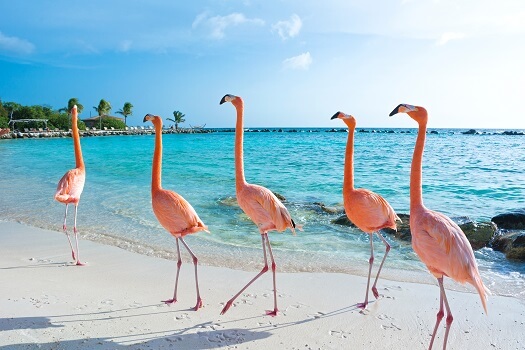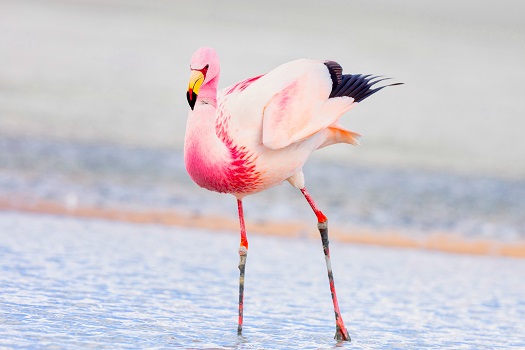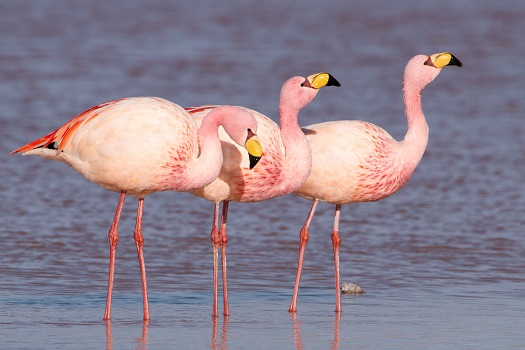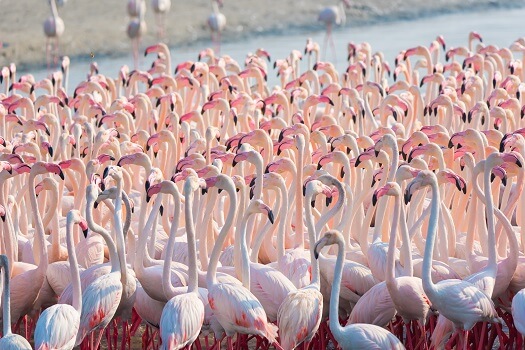
The flamingo is a pink wading bird that has incredibly long legs. ‘Flamingo’ originates from the Spanish word ‘flamenco’ which means fire and refers to the bright pink or orange color of its’ feathers. There are six species in total; four are found in the Americas and two in the old world. Flamingos are found in a variety of habitats, including lakes, lagoons, and swamps. These water bodies are found in both warm and cold areas such as mountains and flatlands. The main requirement for flamingos is access to food sources – they eat small insects, crustaceans, and algae. In fact, it is their food that gives flamingos the pigment that makes their feathers pink or orange in color. Flamingos are filter feeders. They take in water from their environment that contains their food, filter out their food, and then expel the water from their body. The different flamingo species have different shaped beaks that reflect differences in their diet based on their habitats. To find their food, the flamingos will stamp their feet in the mud which helps to bring small organisms to the surface of the water. Then they put their head in the water upside down and move the beak from side to side to collect a mixture of food and water. Flamingos breathe air so while they are feeding they have to hold their breath and they can do this for several minutes! Flamingos reach sexual maturity around six years of age. Unlike many other birds, flamingos pair off for the mating season and some are even monogamous for life. Several mating rituals are performed by the male, including marching, preening, and head-turning. If the female is impressed then they will pair off. If not the male will move on and try to find another mate. Once the flamingos have paired off the male and female work together to build a nest. Then the female will lay a single egg and both parents will take turns incubating it. After 27 to 31 days the egg hatches and the young flamingo spends about a week within the nest being cared for by its parents. After this, it joins the colony and a group of adults look after all the young in the colony. In general, flamingos are not migratory birds and establish permanent colonies. However, due to fluctuating water levels and climate change, some flamingos have been known to migrate, especially those that are found in areas that may freeze over in the winter. Populations that are found in high-altitude lakes may fly to warmer areas to avoid the cold and lack of access to food. There are six species of flamingo in total with four new-world species and two old-world species. The six species are the greater flamingo, Caribbean flamingo, Andean flamingo, lesser flamingo, Jame’s flamingo, and the Chilean flamingo. Greater Flamingo (Phoenicopterus roseus) is an old-world flamingo and the largest of the flamingo species. It has pink and white plumage, pink legs and feet, and a pink beak that has a black tip. This flamingo is the most widespread of all the species and is found in Africa, the Middle East, Southern Europe, and the Indian subcontinent. Caribbean Flamingo (Phoenicopterus ruber) is also known as the American Flamingo. It has deep pink plumage and a pink and white beak with a black tip. It is found in Central and South America, as well as the Caribbean. Andean Flamingo (Phoenicopterus andinus) is pale pink in color, with a darker pink neck and breast. Unlike other flamingo species, the Andean flamingo has a pale yellow beak with a black tip and yellow legs. It resides in the Andes mountains of Southern America and is the rarest of the flamingo species. Lesser Flamingo (Phoenicopterus minor) is the smallest of the Flamingo species. It has pale pink/white plumage and a dark red beak with a black tip. The lesser flamingo is an old-world species and is found in sub-Saharan Africa and northwestern India. James’s Flamingo (Phoenicoparrus jamesi), also known as the puna flamingo, is pale pink in color, like several of the other species but it also has bright carmine (red) streaks on its neck and back. They also have a bright yellow beak with a black tip, red legs, and bright red skin around the eyes. These flamingos are only found in South America, living in the high altitudes of Peru, Chile, Bolivia, and Argentina. Chilean Flamingo (Phoenicopterus chilensis) is a large pink bird that can be distinguished from the other species of flamingos by its grey legs that have pink leg-joints and pink webbed feet. They have a large beak which is pink and black. As their name suggests they can be found in Chile but there are also populations found in Argentina. Flamingos are flamboyant birds that are famous for their pink feathers and long legs! These brightly-colored birds are extremely social and have some wonderful biological adaptations that have helped them to survive in various environments. Let’s take a closer look! These birds are extremely social and need to live in large groups. Wild colonies of flamingos can have thousands of individuals, although most of them are small and contain around 50 flamingos. The largest known group of flamingos lives in East Africa and has more than 1 million members! Staying in large groups protects from potential predators as well as helping with other tasks such as raising chicks. Recent studies have shown just how important social interactions are to flamingos, demonstrating that these birds will form friendships that last their entire life! Not only will couples form bonds and raise chicks together year after year, but small groups of up to six birds can also form lasting friendships. Up to six weeks before an egg is laid, the male and female flamingo will start to build a nest together. Their nests are mounds that can be as high as 12 in (30 cm) and are made of mud, small stones, straw, and feathers. The birds use their feet to push the material together. At the top of the mound, the birds create an indentation – rather like a bowl – that will house the single egg that the female lays. During the incubation period, the birds will continue to build up the mound by adding more and more material to it. Flamingos are filter feeders and as such have many rows of horny plates lining their beaks that they use to strain food from the water. Unlike most other birds, flamingos feed with their heads upside down, and their bills are adapted to suit this method, having a smaller upper beak and a larger lower beak. The upper jaw is not rigidly attached to the skull and so when the head is upside down, the flamingos can move their upper jaw up and down which assists with feeding normally. These birds also have a fat tongue that fits within the bill’s deep central groove and it acts as a pump to help pass water through the bill more efficiently. As the tongue is moved quickly back and forth, water is sucked through the filter as it is pulled backward and expelled out of the beak as it quickly moves forward. The flamingos can move their tongue up to four times a second. While flamingos feed more like baleen whales and some species of sharks than they do like birds, they are not the only avian filter feeders! Some penguins and auks also filter small organisms from the water using simple structures. The Mallard duck also has horny plates and an enlarged tongue but only the flamingos feed upside down and have a larger lower mandible.
Kingdom
Animalia
Phylum
Chordata
Class
Aves
Order
Phoenicopteriformes
Family
Phoenicopteridae
Genus
3
Species
6
Height
2.6 – 4.7 feet (0.8 – 1.4 meters)
Weight
5.5 – 7.7 pounds (2.5 – 3.5 kilograms)
Lifespan
20 – 30 years in the wild, up to 50 years in captivity
Status
Least concern
Preferred Habitat
Varied; must have water such as lakes and swamps
Average Clutch size
1
Main food item
Crustaceans, insects, and algae
Main predators
Varies by species, includes cheetahs, lions, foxes, and snakes
The Basics

How Many Species of Flamingo Are There?

Fun Facts About The Flamingo!
Extremely Social

Flamingos Build Large Nests
Flamingo Feeding
